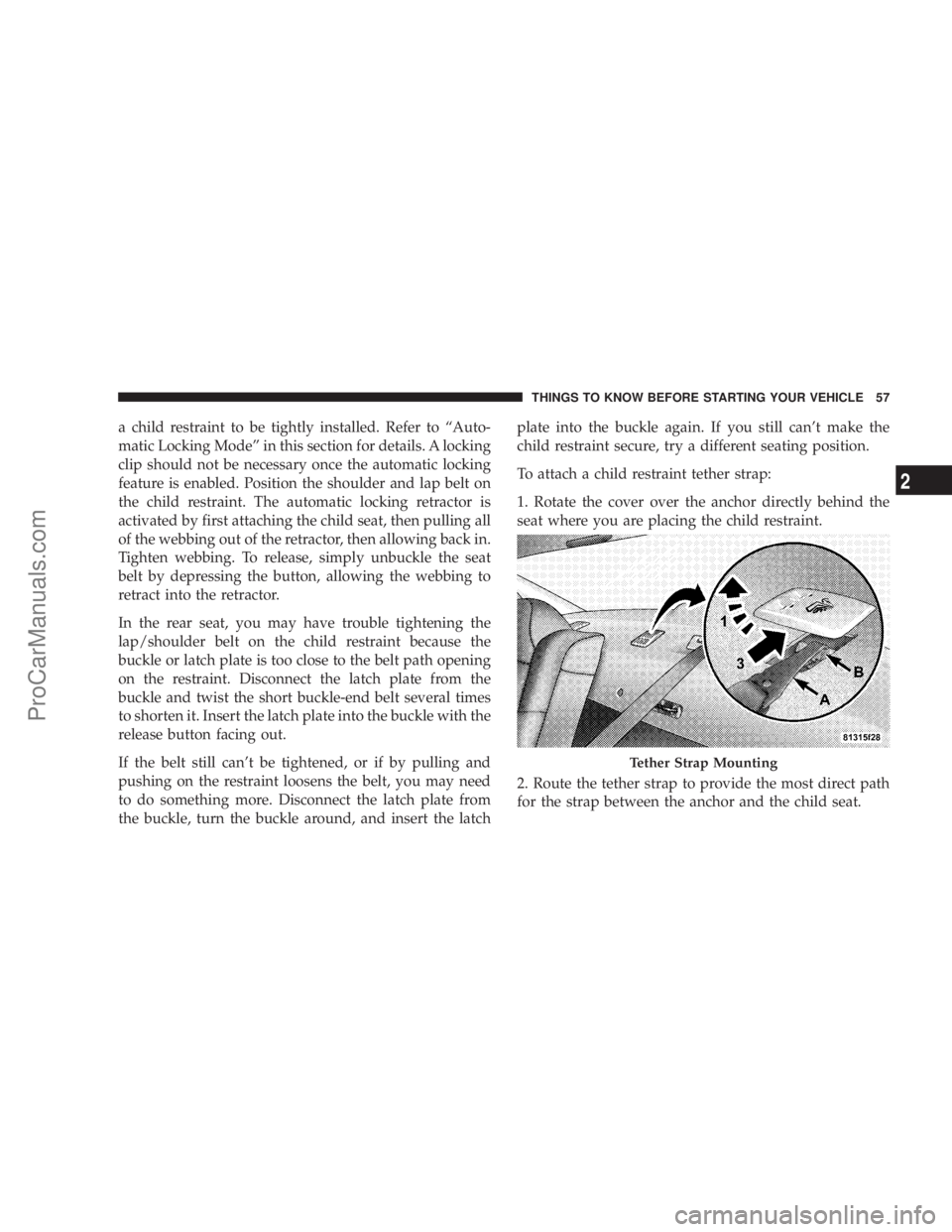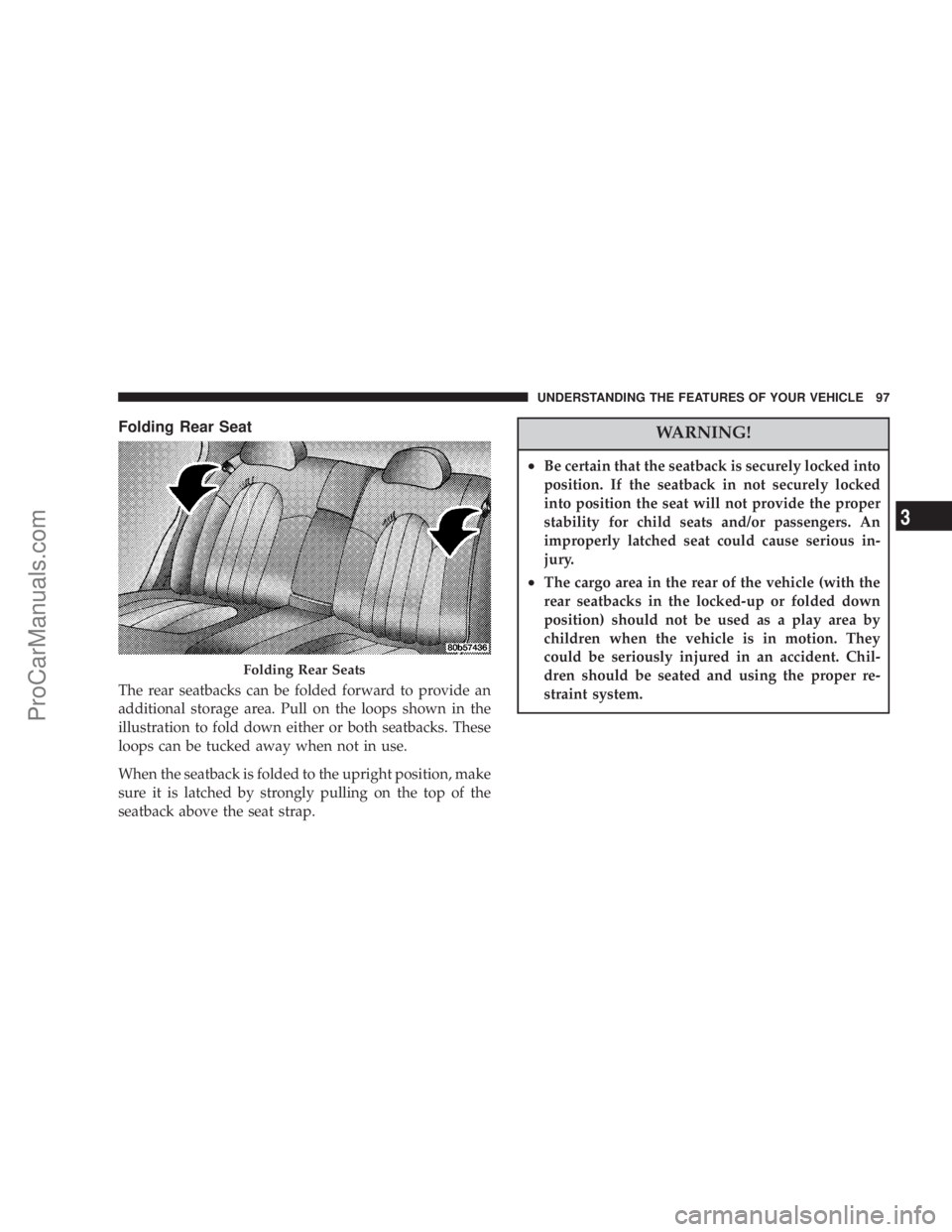2007 CHRYSLER 300 LX child lock
[x] Cancel search: child lockPage 40 of 432

distinctive label on the webbing. Children 12 years old
and under should be properly restrained in the rear seat
whenever possible.
How To Engage The Automatic Locking Mode
1. Buckle the combination lap and shoulder belt.
2. Grasp the shoulder portion and pull downward until
the entire belt is extracted.
3. Allow the belt to retract. As the belt retracts, you will
here a clicking sound. This indicates the safety belt is
now in the automatic locking mode.
How To Disengage The Automatic Locking Mode
Unbuckle the combination lap and shoulder belt and
allow it to retract completely to disengage the automatic
locking mode and activate the vehicle sensitive (emer-
gency) locking mode.
Seat Belts and Pregnant Women
We recommend that pregnant women use the seat belts
throughout their pregnancy. Keeping the mother safe is
the best way to keep the baby safe.
Pregnant women should wear the lap part of the belt
across the thighs and as snug across the hips as possible.
Keep the belt low so that it does not come across the
abdomen. That way the strong bones of the hips will take
the force if there is a collision.
Seat Belt Extender
If a seat belt is too short, even when fully extended, and
when the adjustable upper shoulder belt anchorage (if so
equipped) is in its lowest position, your dealer can
provide you with a seat belt extender. This extender
should be used only if the existing belt is not long
enough. When it is not required, remove the extender,
and store it.
40 THINGS TO KNOW BEFORE STARTING YOUR VEHICLE
ProCarManuals.com
Page 56 of 432

NOTE:
•
Ensure that the tether strap does not slip into the
opening between the seat backs as you remove slack in
the strap.
•When using the LATCH attaching system to install a
child restraint, please ensure that all seat belts not
being used for occupant restraints are stowed and out
of reach of children. It is recommended that before
installing the child restraint, buckle the seat belt so the
seat belt is tucked behind the child restraint and out of
reach. If the buckled seat belt interferes with the child
restraint installation, instead of tucking the seat belt
behind the child restraint, route the seat belt through
the child restraint belt path and then buckle it. This
should stow the seat belt out of the reach of an
inquisitive child. Remind all children in the vehicle
that the seat belts are not toys and should not be
played with, and never leave your child unattended in
the vehicle.
WARNING!
Improper installation of a child restraint to the
LATCH anchorages can lead to failure of an infant or
child restraint. The child could be badly injured or
killed. Follow the manufacturer’s directions exactly
when installing an infant or child restraint.
Installing Child Restraints Using the Vehicle Seat
belt
The passenger seat belts are equipped with either cinch-
ing latch plates or automatic locking retractors, which are
designed to keep the lap portion tight around the child
restraint so that it is not necessary to use a locking clip.
Pulling up on the shoulder portion of the lap/shoulder
belt will tighten the belt. The cinching latch plate will
keep the belt tight, however, any seat belt system will
loosen with time, so check the belt occasionally, and pull
it tight if necessary.
Seat belts with an automatic locking retractor have a
distinctive label on the seat belt webbing. The seat belt
must be in the automatic locking mode in order to enable
56 THINGS TO KNOW BEFORE STARTING YOUR VEHICLE
ProCarManuals.com
Page 57 of 432

a child restraint to be tightly installed. Refer to “Auto-
matic Locking Mode” in this section for details. A locking
clip should not be necessary once the automatic locking
feature is enabled. Position the shoulder and lap belt on
the child restraint. The automatic locking retractor is
activated by first attaching the child seat, then pulling all
of the webbing out of the retractor, then allowing back in.
Tighten webbing. To release, simply unbuckle the seat
belt by depressing the button, allowing the webbing to
retract into the retractor.
In the rear seat, you may have trouble tightening the
lap/shoulder belt on the child restraint because the
buckle or latch plate is too close to the belt path opening
on the restraint. Disconnect the latch plate from the
buckle and twist the short buckle-end belt several times
to shorten it. Insert the latch plate into the buckle with the
release button facing out.
If the belt still can’t be tightened, or if by pulling and
pushing on the restraint loosens the belt, you may need
to do something more. Disconnect the latch plate from
the buckle, turn the buckle around, and insert the latchplate into the buckle again. If you still can’t make the
child restraint secure, try a different seating position.
To attach a child restraint tether strap:
1. Rotate the cover over the anchor directly behind the
seat where you are placing the child restraint.
2. Route the tether strap to provide the most direct path
for the strap between the anchor and the child seat.
Tether Strap Mounting
THINGS TO KNOW BEFORE STARTING YOUR VEHICLE 57
2
ProCarManuals.com
Page 97 of 432

Folding Rear Seat
The rear seatbacks can be folded forward to provide an
additional storage area. Pull on the loops shown in the
illustration to fold down either or both seatbacks. These
loops can be tucked away when not in use.
When the seatback is folded to the upright position, make
sure it is latched by strongly pulling on the top of the
seatback above the seat strap.
WARNING!
•Be certain that the seatback is securely locked into
position. If the seatback in not securely locked
into position the seat will not provide the proper
stability for child seats and/or passengers. An
improperly latched seat could cause serious in-
jury.
•The cargo area in the rear of the vehicle (with the
rear seatbacks in the locked-up or folded down
position) should not be used as a play area by
children when the vehicle is in motion. They
could be seriously injured in an accident. Chil-
dren should be seated and using the proper re-
straint system.
Folding Rear Seats
UNDERSTANDING THE FEATURES OF YOUR VEHICLE 97
3
ProCarManuals.com
Page 154 of 432

WARNING!
•Be certain that the seatback is securely locked into
position. If the seatback in not securely locked
into position, the seat will not provide the proper
stability for child seats and/or passengers. An
improperly latched seat could cause serious in-
jury.
•The cargo area in the rear of the vehicle (with the
rear seatbacks in the locked-up or folded down
position) should not be used as a play area by
children when the vehicle is in motion. They
could be seriously injured in an accident. Chil-
dren should be seated and using the proper re-
straint system.
•To help protect against personal injury, passen-
gers should not be seated in the rear cargo area.
The rear cargo space is intended for load carrying
purposes only, not for passengers, who should sit
in seats and use seat belts.
WARNING!
•The weight and position of cargo and passengers
can change the vehicle center of gravity and
vehicle handling. To avoid loss of control result-
ing in personal injury, follow these guidelines for
loading your vehicle:
•Always place cargo evenly on the cargo floor. Put
heavier objects as low and as far forward as possible.
•Place as much cargo as possible in front of the rear
axle. Too much weight or improperly placed weight
over or behind the rear axle can cause the rear of the
vehicle to sway.
•Do not pile luggage or cargo higher than the top of the
seatback. This could impair visibility or become a
dangerous projectile in a sudden stop or collision.
154 UNDERSTANDING THE FEATURES OF YOUR VEHICLE
ProCarManuals.com
Page 239 of 432

The selector lever is automatically locked while in the P
(Park) position. To move the selector lever out of the P
(Park) position, the brake pedal must be firmly depressed
before the shift lock will release.
Shift the selector lever to the desired position only when
the engine is idling normally and the brake pedal is
applied. Do not release the brake until ready to drive. The
vehicle may otherwise accelerate quickly when the selec-
tor lever is in D (Drive) or R (Reverse) position.WARNING!
Unintended movement of a vehicle could injure
those in and near the vehicle. As with all vehicles,
you should never exit a vehicle while the engine is
running. Before exiting a vehicle, you should always
shift the vehicle into P (Park), remove the key from
the ignition, and apply the parking brake. Once the
key is removed from the ignition, the transmission
selector lever is locked in the P (Park) position,
securing the vehicle against unwanted movement.
Furthermore, you should never leave children unat-
tended inside a vehicle.
Over Temperature Mode
The transmission electronics constantly monitor the
transmission oil temperature. If the transmission exceeds
normal operating temperature, the transmission will
change the way it shifts to help control the condition.
This may result in a slightly different feeling or response
during normal operation in D (Drive) position. After the
transmission cools down, it will return to normal opera-
tion.
STARTING AND OPERATING 239
5
ProCarManuals.com
Page 416 of 432

Cassette Tape and Player Maintenance....... 217
Catalytic Converter..................... 341
CD (Compact Disc) Player.............188,195
Cellular Phone.......................... 72
Chains, Tire........................... 279
Changing A Flat Tire.................... 314
Chart, Tire Sizing....................... 264
Check Engine Light
(Malfunction Indicator Light).............. 333
Child Restraint...................50,52,55,56
Child Restraint Tether Anchors...........54,55
Child Safety Locks....................... 25
Clean Air Gasoline...................... 290
Cleaning
Wheels............................. 360
Climate Control........................ 219
Clock.......................186,190,196,207
Compact Disc (CD) Maintenance........... 218
Compact Spare Tire..................... 274
Compass............................. 178
Compass Calibration.................... 178
Compass Variance...................... 179
Computer, Trip/Travel................... 175Console.............................. 153
Console, Floor......................... 153
Console, Overhead...................... 140
Contract, Service....................... 408
Coolant Pressure Cap (Radiator Cap)........ 351
Cooling System........................ 349
Adding Coolant (Antifreeze)............. 351
Coolant Capacity..................... 382
Coolant Level.....................349,352
Disposal of Used Coolant............... 352
Drain, Flush, and Refill................. 350
Inspection........................... 352
Points to Remember................... 352
Pressure Cap........................ 351
Radiator Cap........................ 351
Selection of Coolant (Antifreeze)....350,382,383
Cruise Control (Speed Control).......... 118,121
Cruise Light........................... 163
Cup Holder.....................151,362,363
Customer Assistance.................... 406
Data Recorder, Event..................... 49
Daytime Running Lights................. 106
416 INDEX
ProCarManuals.com
Page 422 of 432

Vanity Mirror......................... 71
Voltage............................. 170
Warning (Instrument Cluster Description) . . . 163
Load Leveling System................... 155
Loading Vehicle.....................295,297
Capacities........................... 297
Tires ............................... 267
Locks................................ 22
Auto Unlock......................... 25
Child Protection....................... 25
Door............................... 22
Power Door.......................... 23
Low Tire Pressure System................ 281
Lower Anchors and Tether for CHildren
(LATCH)............................54,55
Lubrication, Body....................... 346
Lumbar Support........................ 94
Maintenance Free Battery................. 343
Maintenance Procedures.................. 335
Maintenance Schedule................... 386
Schedule “A”........................ 399
Schedule “B”........................ 389Malfunction Indicator Light
(Check Engine)......................170,333
Manual, Service........................ 409
Memory Feature (Memory Seat)............. 98
Memory Seat........................... 98
Memory Seats and Radio.................. 98
Methanol............................. 290
Mini-Trip Computer..................... 175
Mirrors............................... 68
Automatic Dimming.................... 68
Electric Remote....................... 70
Exterior Folding....................... 69
Heated.............................. 71
Outside............................. 69
Rearview............................ 68
Vanity.............................. 71
Modifications/Alterations, Vehicle............ 7
Monitor, Tire Pressure System............. 281
Mopar Parts........................334,408
MTBE/ETBE.......................... 290
Multi-Displacement Engine System.......... 256
Multi-Function Control Lever.............. 106
422 INDEX
ProCarManuals.com